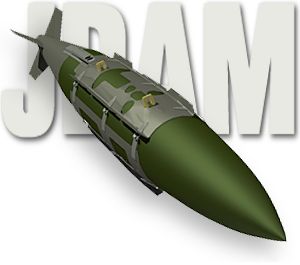
JDAM (Joint Direct Attack Munition)

Program Description
A Joint Air Force/Navy program to provide current fighter and bomber aircraft the
capability to accurately and precisely attack fixed, or relocatable, land and maritime
targets under adverse weather conditions from medium and high altitudes.
In October 1995, McDonnell Douglas won a $63 million U.S. Department of Defense competition for development of the Joint Direct Attack Munition (JDAM). Production orders could total about $4 billion over the next two decades. JDAM is a guidance kit that converts existing 1,000-pound and 2,000-pound unguided, free-falling bombs into precision-guided "smart" munitions that can autonomously strike targets in all weather conditions. JDAM also minimizes collateral damage while leaving strike aircraft crews less exposed to hostile fire.
| The Joint Direct
Attack Munition (JDAM) is a guidance kit that converts existing unguided free-fall bombs
into precision-guided "smart" munitions. By adding a new tail section containing
global positioning system (GPS)/inertial navigation system (INS) guidance control unit to
existing inventories of Mk-83 and BLU-110 1,000-pound bombs, and the Mk-84 and BLU-109
2,000 pound bombs, the cost-effective JDAM will dramatically improve the accuracy of
precision strike munitions in adverse weather. JDAM can be dropped by an aircraft from up
to 15 miles from the target. Updates from GPS satellites will help guide the bomb to the
target. The JDAM production team includes Lockheed Martin Tactical Defense Systems for the mission computer, Honeywell Inc.. for the inertial measurement unit, Rockwell-Collins for the global positioning system receiver, HR Textron for the tail actuator subsystem, Lockley for the tail fairing, Enser and Eagle-Picher for the battery, and MDI and Lambda for the power supply. The team has completed a $45 million contract for pre-engineering and manufacturing development (EMD). Throughout the pre-EMD the team consistently met or exceeded all major milestones ahead of schedule and below cost. The end result was a JDAM design that will exceed all reliability, maintainability and support requirements. Boeing has provided a 20-year warranty on JDAM at no charge to the customer. In addition, the design is guaranteed to be maintenance free for its 20-year life and implementation will require no new support equipment or skills. JDAM is currently in the engineering, manufacturing and development phase of a $70 million joint Air Force, Navy, Marine Corps program. JDAM is one of seven pilot programs selected by the U.S. Department of Defense to test methods for streamlining the acquisition process. No military standards or specifications were applied to the JDAM program and, by incorporating the use of commercial practices and off-the-shelf components where practical, the team was able to significantly improve the system's affordability. On May 29, 1996, the JDAM team was awarded the prestigious Acquisition Lightning Bolt Award by Mr. Arthur Money, Assistant Secretary for the Air Force for Acquisition. On April 30, 1997, the Air Force announced the decision to initiate low-rate initial production (LRIP) of JDAM, with the first production lot of 937 JDAM kits. The JDAM Integrated Product Team achieved a phenomenal 53 guided JDAM weapon releases in the six months prior to the LRIP decision. JDAM demonstrated high reliability and outstanding accuracy. Twenty-two of the weapon releases were accomplished during an early Air Force operational assessment. Over a four-week period operational crews put JDAM through an operationally representative evaluation, including targets shrouded by clouds and obscured by snow. All 22 weapons successfully performed up to their operational requirements including overall accuracy of 10.3 meters, significantly better than the 13 meter requirement. JDAM has successfully accomplished guided releases from the F/A-18, F-16, and B-2 aircraft. Integration is ongoing with the B-1B, B52-H, and AV-8B. The Department of Defense plans to buy 87,496 JDAMs for use by the Air Force and Navy under a production program that is expected to continue well into the next century. The estimated overall value of the program exceeds $2 billion. |
Courtesy McDonnell Douglas-Boeing